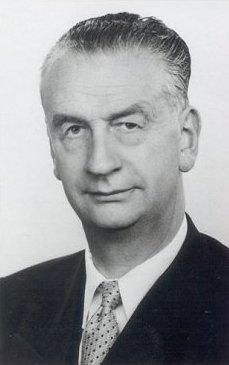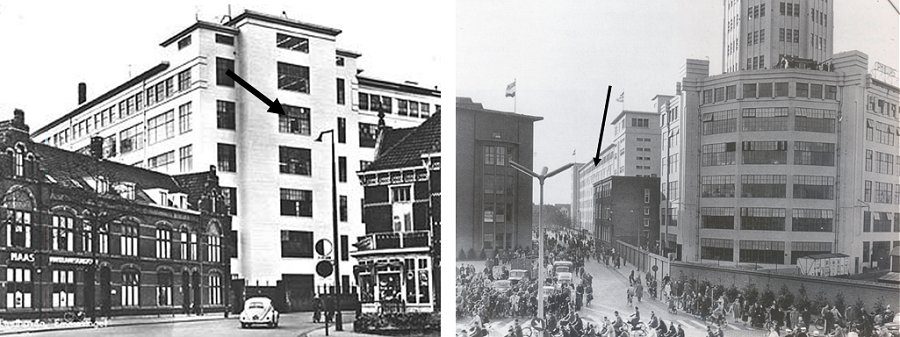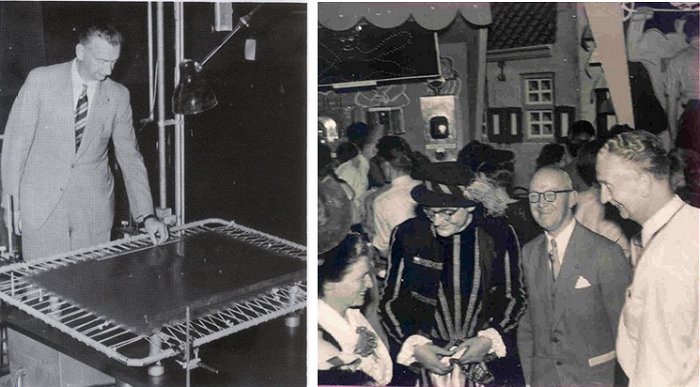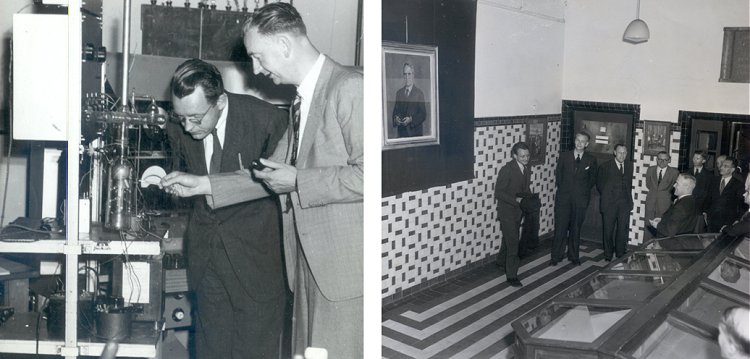

Johan Lodewijk (Hans) Jonker was born on the 19th of March 1901 in Den Haag (The Hague). From Sept. 1915 to Sept. 1920 he attended the H.B.S. High School in Den Haag. Being born five years before the invention of the triode by Lee De Forest, it is easy to understand how these revolutionary new technological developments must have appealed to the young Jonker when he was in his teens. According to his widow he was always experimenting with wires and other electrical stuff. Besides this, Jonker is also artistically gifted. He makes beautiful pictures and drawings, and for some time he is tempted to pursue a career in the arts. After his father advices him that “unless you are very good, it is difficult to make a decent living in the arts,” he decides for a scientific career.
After high school he goes to Delft to study electrical engineering at the Delft University of Technology. During his studies he develops an active interest in electronics and he publishes several papers in “Radio-Nieuws”. “Radio-Nieuws” (Radio News) was a periodical for radio pioneers and amateurs that was published between 1917 and 1933. Copies of “Radio-Nieuws” are still kept in the antiquarian book department, “the tresor” (archive) of the central library at the University of Delft. His first contribution to “Radio-Nieuws” dates from 1920 written at the age of 19. It discussed the fabrication of electrolytic rectifiers. The second paper, two years later, discusses a universal measuring tool.
After he received his master’s degree in January 1925 he takes up a job at the cooperative sugar factory “Dinteloord” in the small town of Stampersgat near the city of Roosendaal. For a young man who grew up in the sophisticated area of Den Haag and Delft, the transition to the desolate agricultural area of Dinteloord must have been a shock. It is therefore no surprise that in slightly more than a year, in September 1926 he returns to Den Haag for a position at the Dutch Patent office.

Figure 1. Jonker worked at “SPLENDOR” on the development of radio tubes from July 1927 until January 1939. In the right picture Jonker is the third person seated from the left.
At the age of 26, Jonker takes up his third job in July 1927 when he becomes an employee of the “SPLENDOR” Light-bulk factory in Nijmegen. In 1919 the “Gloeilampfabriek Nijmegen NV” (lightbulb factory Nijmegen) was registered and production was started in a small factory at the Van Gentstraat 70-74 in Nijmegen. In 1926 the brand name SPLENDOR was introduced. Under this name the company was well known in Holland for its high quality products. Eventually, due to competition from the Far East, SPLENDOR was forced to close its factories in 1977. At Splendor, Jonker was in charge of radio tube development and production. The activity certainly can not have been a large one since very little is known about SPLENDOR radio “lamps” anymore.

Figure 2. This enormous white building housed the radio tube fabrication division. All radio tubes fabricated by Philips in Holland were made here. The building is known in Eindhoven as “de witte dame” (the white lady). The photographs show the white lady from both ends of the Emma single. The arrows show the floor where the tube lab was located and where the E1T was fabricated.

Figure 3. A Photograph taken from Jonker’s PhD thesis depicting the “rubber-sheet” electron trajectory simulator.
In January 1930 Jonker joins the radio tube research group at the Philips Research. On the first of November 1931 he leaves Research to found and organize a radio-tube development department in the Radio tube production plant on the Emmasingel. The radio-tube development department was at that timeknown as “the Jonker Lab (Radio IV),” and became later known as “buizenlab” (the tube-lab).
Five years later Jonker returns to the Research Lab on the 19 September 1936. Jonker is now in charge of the tube research group.

Figure 4. Two electron trajectory simulation examples from Jonker’s thesis. The picture on the left depicts a tube with a positively biased grid with the anode on a relatively low potential. Only the electrons that are not deflected by the grid wires reach the anode while the others are reflected. On the right we find the same situation, but now the anode is at cathode potential. No electrons reach the anode, they circle around the grid wires.
Around that time a great tragedy occurs in Jonker’s life when he loses his wife and child. He soon marries again and within a few years three daughters are born. When the Germans invade Holland in 1940, Jonker is among a group of people that Philips decides to evacuate to England. While Jonker’s wife and their baby daughter make their way to den Haag on their own, Jonker follows with the rest of the Philips group. When they arrive in Moerdijk the bridges over “het Hollands Diep” are blocked by the Germans. For several days the Philips party is stuck in Moerdijk where they stay at a convent. Then after a few days Jonker acquires a bicycle and cycles to den Haag where he is re-united with his wife and daughter. Together they find their way back to Eindhoven.

Figure 5. On the left Jonker demonstrates the electron trajectory simulator. The right picture was taken during a huge party celebrating the opening of a new wing of the NatLab building at “the Kastanjelaan”. From left to right we see Mrs Jonker, Dr Casimir, van Kolfschoten (mayor of Eindhoven) and Jonker.
One way or the other normal life is resumed, and in the middle of the second word war in occupied Holland on the 5th of June 1942, Jonker defends his PhD thesis at the technical university of Delft. The title of his thesis is “Stroomverdeling in versterkerbuizen” (Current distribution in amplifying tubes). The main topic of the thesis is the calculation of electron trajectories in electron tubes. Except for some very simple configurations, it was at that time not possible to calculate the exact trajectory of electrons in an arbitrary electrode configuration. In order to simulate the electron trajectories, Jonker and his workers create a mechanical simulator consisting of a rubber foil suspended in a metal frame (Fig. 3,5). The height of the foil is a measure for the potential. At the position of a positively charged grid wire the foil is pulled down, while it is pushed up at the position of a negative grid wire. Small steel bearing balls are ejected at the edge of the foil (at the position of the cathode). The trajectory of the bullets is photographed by a camera positioned above the foil. Even the speed of the electrons can be determined with the aid of stroboscopic illumination (Fig. 4). All in all the thesis gives a charming impression of how researchers, with modest means in a war time situation, achieved impressive results.

Figure 6. Jonker after his inaugural speech on March 19, 1952 when he accepted his professorship at the University of Delft.
The calculation of electron trajectories was just one of the many topics addressed by Jonkers research group. Another important topic was the study of the phenomenon of secondary emission. This effect was originally not well understood and often interfered with the proper operation of radio-tubes. Later when it became better understood, it was advantageously used in e.g. photomultipliers and certain switching tubes.
Other research topics included: high frequency and high power transmission tubes including magnetrons, klystrons and traveling wave tubes, cathode ray tubes and camera tubes.

Figure 7. Jonkers group during a group outing to Germany. Arrow 1 points to Jonker, arrow 2 points to van Overbeek, the inventor of the E1T.
One of the more important inventions originating from the NatLab during that period is the so called Lemmens cathode. At that time oxide coated cathodes were preferred for application in radio-tubes because of their relatively high emission efficiency. These cathodes are however not very suitable for the new category of high-frequency high-power tubes. These applications require high current density emission, while at the same time they have to be resistant to the electrostatic forces due to the high voltages used as well as to the bombardment by accelerated backscattered electrons. Moreover, the relatively small oxide volume strongly limites the lifetime of the cathode. Lemmens, one of the craftsmen in charge of the tube workshop constructed a cathode consisting of a molybdenum cylinder containing an isolated filament and a pill of barium-strontium oxide. The cylinder was closed by a porous tungsten cap. The cathode combined excellent emission properties and long lifetime with a high mechanical strength. The cathode became known as the L-cathode and enabled the development of high-power and long lifetime transmission tubes.

Figure 8. Two unique photographs of Jonker. On the left Jonker demonstrates an experimental setup to Hendrik Casimir, the brilliant scientist and future director of the research lab. On the right Holst is offered a painting of himself by Casimir. Casimir is on the left, Jonker is the second person from left and Holst the fifth. Today the painting hangs in the auditorium at Philips Research.
In the fifties Jonker is heavily involved with the foundation of a new Technical University at Eindhoven. On the 30th of November 1956, Jonker resigns from Philips and becomes one of the first professors of the electrical engineering faculty at this new university together with: Niesten and Zwikker. In the spring of 1963 Jonker begins to tire easily, and he does not feel well. After a few months of illness he dies on the 11th of July 1963 at the early age of 62.
At the writing of this page Mrs. Jonker is now 100, and she still lives on her own in the beautiful house that she and Jonker built more than seventy years ago, and where she was kind enough to give me an interview.
She remembers her husband as a very kind and dear man, who’s only shortcoming was that he found it difficult to talk about his feelings. He rarely talked with her about his life before their marriage. Jonker continued painting all his life and the house is graced with many paintings of their daughters and of flowers. This brings us to the other great passion of Jonker: raising orchids. Every morning before he left for work he would look into the small greenhouse in the garden to see how his orchids were doing. In addition to this he participated in many social and cultural activities in and around Eindhoven.